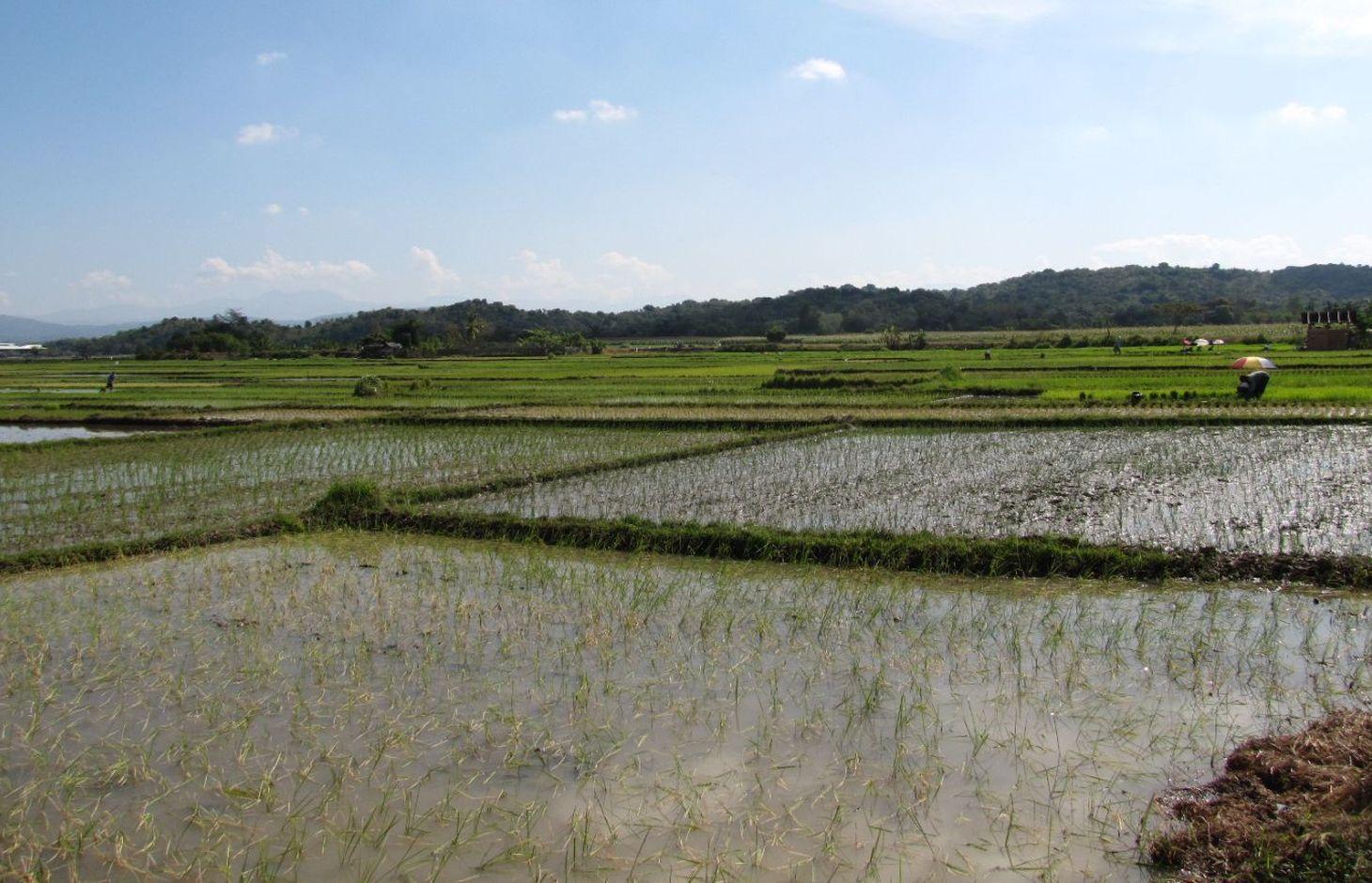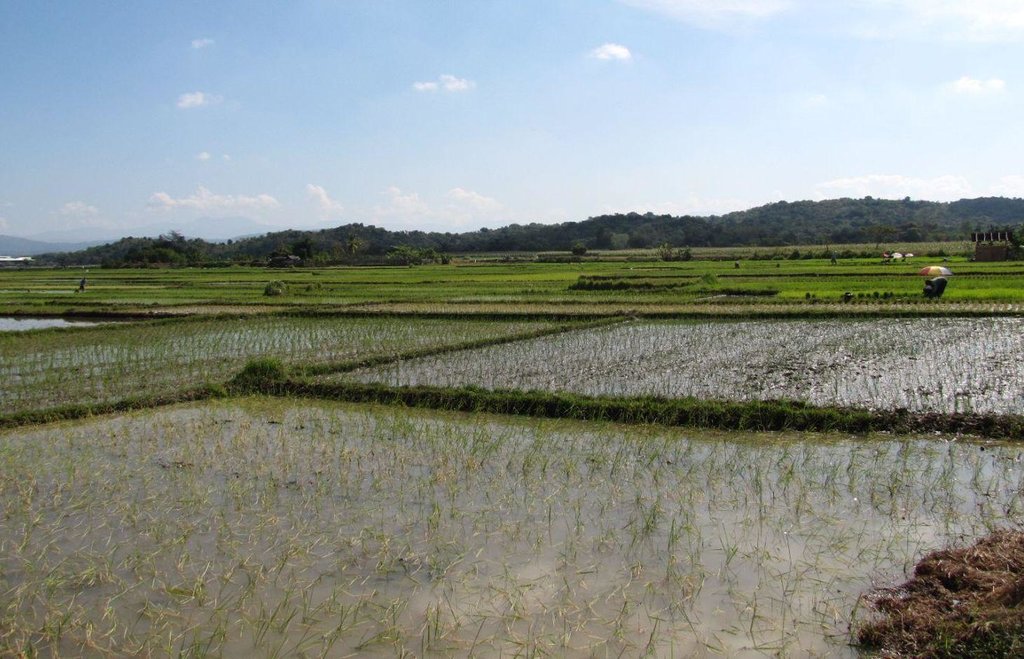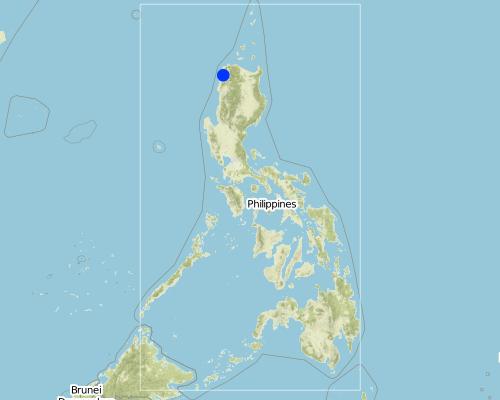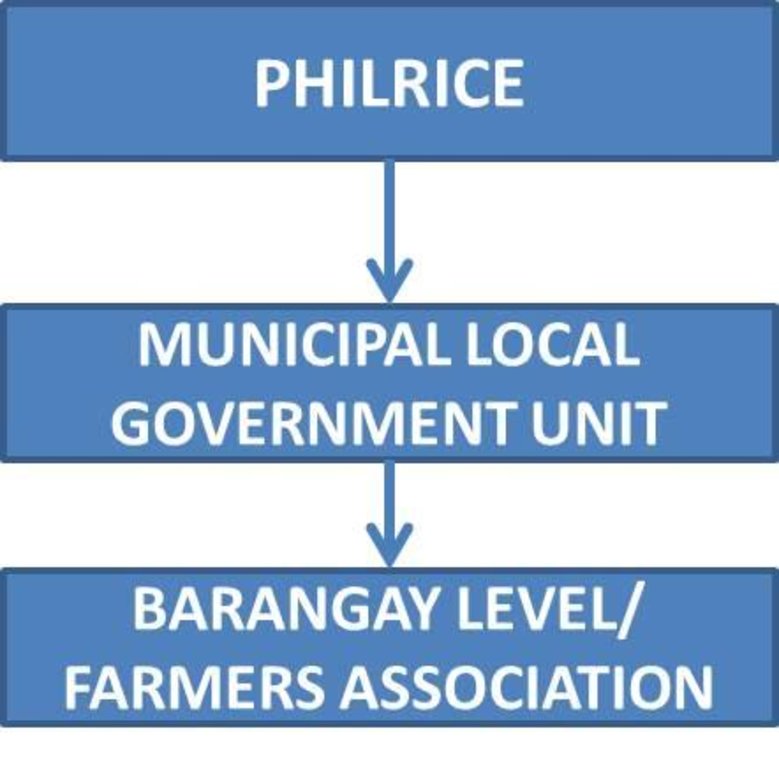Palayamanan: Climate Change Adaptation Strategy for Lowland Ecosystem [ฟิลิปปินส์]
- ผู้สร้างสรรค์:
- การอัพเดท:
- ผู้รวบรวม: Philippine Overview of Conservation Approaches and Technologies
- ผู้เรียบเรียง: –
- ผู้ตรวจสอบ: Deborah Niggli
Palayamanan
approaches_1972 - ฟิลิปปินส์
ดูส่วนย่อย
ขยายทั้งหมด ย่อทั้งหมด1. ข้อมูลทั่วไป
1.2 รายละเอียดที่ติดต่อได้ของผู้รวบรวมและองค์กรที่เกี่ยวข้องในการประเมินและการจัดเตรียมทำเอกสารของแนวทาง
ผู้เชี่ยวชาญ SLM:
Corales Dr.Rizal G.
rg.corales@philrice.gov.ph
Philippine Rice Research Institute
Science City of Munoz
ฟิลิปปินส์
ผู้เชี่ยวชาญ SLM:
Baradi Dr. Mary Ann U.
Philippine Rice Research Institute
Batac City
ฟิลิปปินส์
ชื่อของโครงการซึ่งอำนวยความสะดวกในการทำเอกสารหรือการประเมินแนวทาง (ถ้าเกี่ยวข้อง)
Decision Support for Mainstreaming and Scaling out Sustainable Land Management (GEF-FAO / DS-SLM)ชื่อของโครงการซึ่งอำนวยความสะดวกในการทำเอกสารหรือการประเมินแนวทาง (ถ้าเกี่ยวข้อง)
Department of Agriculture-Region VIII (DA-8) - ฟิลิปปินส์1.3 เงื่อนไขที่เกี่ยวข้องกับการใช้ข้อมูลที่ได้บันทึกไว้ผ่านทาง WOCAT
วันที่เก็บรวบรวมข้อมูล (ภาคสนาม):
10/03/2016
ผู้รวบรวมและวิทยากรหลักยอมรับเงื่อนไขเกี่ยวกับการใช้ข้อมูลที่ถูกบันทึกผ่านทาง WOCAT:
ใช่
1.4 การอ้างอิงถึงแบบสอบถามเรื่องเทคโนโลยี SLM
2. คำอธิบายของแนวทาง SLM
2.1 การอธิบายแบบสั้น ๆ ของแนวทาง
Synergistic mix of farming ventures implemented by the farm family based on the existing environment and their resources to address food security, income instability, and sustainability.
2.2 การอธิบายอย่างละเอียดของแนวทาง
การอธิบายอย่างละเอียดของแนวทาง:
The objectives of the approach are the following: to improve resources allocation; to enhance biodiversity and ecological balance; to reduce production risks; and to increase cropping intensity, productivity, profitability, and economic stability. It also includes continuous food supply and higher income for land users. With Palayamanan, the farm is not just intended for rice. It is about food security, livelihood and empowering farmers to become better decision makers and resilient to climate change. It also aims to develop land users to become farmer-researchers, extension workers and entrepreneurs.
Methods: Participatory approach with the stakeholders/land users.
Implementation comprised the following stages: (1) Selection of the demonstration sites an farmer-partners; (2) Conduct participatory rapid appraisal on the sites; (3) Planning; (4) Conduct of training for the farmers (Farmers Field School) and for the Agricultural Extension Workers; (5) Establishment of the demonstration farm; (6) Monitoring and Evaluation; and (7) Human Resource Development for Farmers (to become farmer-researcher, extension worker, entrepreneur)
Stakeholders: A. Philippine Rice Research Institute (PhilRice): take the lead in the implementation of the program; facilitate the conduct of training;provide technical assistance to the program; and monitor the progress of the program.
B. Local Government Unit (Agriculture Office): provide support to the activities of the program; spearhead the dissemination and expansion of the program within their concerned municipality.
C. Farmer: participate in various activities of the program from planning to establishment; conduct on-site researches.
The approach introduced a systematized method of farm management involving technologies and practices to utilize available resources without compromising human health and environment. Some of the technologies incorporated under this approach are the following: crop rotation, aquaculture, waste recycling, diversified cropping, alternate wetting and drying, nutrient management, and integrated pest management.
2.3 รูปภาพของแนวทาง
2.5 ประเทศ ภูมิภาค หรือสถานที่ตั้งที่ได้นำแนวทางไปใช้
ประเทศ:
ฟิลิปปินส์
ภูมิภาค/รัฐ/จังหวัด: :
San Nicolas, Dingras, Currimao, Ilocos Norte
Map
×2.6 วันที่เริ่มต้นและสิ้นสุดของแนวทาง
ระบุปีที่เริ่ม:
2001
การสิ้นสุดลง (ถ้าแนวทางไม่ได้ใช้อีกต่อไป):
2009
ความคิดเห็น:
Introduced by the Philippine Rice Research Institute (PhilRice)
2.7 ประเภทของแนวทาง
- ใช้โครงงานหรือแผนงานเป็นฐาน
2.8 เป้าหมายหรือวัตถุประสงค์หลักของแนวทาง
The objectives of the approach are the following: to improve resources allocation; to enhance biodiversity and ecological balance; to reduce production risks; to increase cropping intensity, productivity, profitability, and economic stability. It also includes continuous food supply and higher income for land users. With Palayamanan, the farm is not just intended for rice. It is about food security, livelihood and empowering farmers to become better decision makers and resilient to climate change.It also aims to develop land users to become farmer-researchers, extension workers and entrepreneurs.
2.9 เงื่อนไขที่เอื้ออำนวยหรือเป็นอุปสรรคต่อการนำเทคโนโลยีภายใต้แนวทางนี้ไปปฏิบัติใช้
การมีไว้ให้หรือการเข้าถึงแหล่งการเงินและบริการ
- เอื้ออำนวย
Organized the League of Sangguniang Bayan Chairperson for Agriculture to ensure the source of finance for the expansion areas
การจัดตั้งระดับองค์กร
- เอื้ออำนวย
LGUs were involved and invited during training, seminars and other activities related to the Palayamanan during the implementation to gain their support in the sustainability of the program; Organization of farmers association.
ความรู้เกี่ยวกับ SLM การเข้าถึงการสนับสนุนด้านเทคนิค
- เอื้ออำนวย
capacity building and training such as conduct of Farmers Field School.
3. การมีส่วนร่วมและบทบาทของผู้มีส่วนได้ส่วนเสียที่เกี่ยวข้อง
3.1 ผู้มีส่วนได้ส่วนเสียที่เกี่ยวข้องในแนวทางนี้และบทบาท
- ผู้ใช้ที่ดินระดับท้องถิ่นหรือชุมชนระดับท้องถิ่น
- ผู้เชี่ยวชาญ SLM หรือที่ปรึกษาการเกษตร
- รัฐบาลระดับท้องถิ่น
Local Government Unit
3.2 การเกี่ยวข้องของผู้ใช้ที่ดินระดับท้องถิ่นหรือชุมชนระดับท้องถิ่นในช่วงต่างๆของแนวทาง
| ความเกี่ยวข้องของผู้ใช้ที่ดินระดับท้องถิ่นหรือชุมชนระดับท้องถิ่น | ระบุผู้ที่มีส่วนเกี่ยวข้องและอธิบายกิจกรรม | |
|---|---|---|
| การริเริ่มหรือการจูงใจ | ไม่ลงมือ | land users were informed about the program through technical briefing/consultation meetings |
| การวางแผน | ปฏิสัมพันธ์ | PhilRice in consultation with the land users and LGUs |
| การดำเนินการ | ปฏิสัมพันธ์ | Land users have the option on what technologies they will implement with the technical assistance of PhilRice |
| การติดตามตรวจสอบหรือการประเมินผล | ปฏิสัมพันธ์ | farm record keeping, testimonial during field day and Palayamanan Congress, land user as correspondent during project monitoring |
| research | ปฏิสัมพันธ์ | land users developed their own on-site research; they presented the results in a research study paper contest during Palayamanan Congress |
3.3 แผนผังแสดงขั้นตอนการทำงาน (ถ้ามี)
คำอธิบาย:
PhilRice introduced and implemented the Palayamanan to one barangay per municipality. The concerned Local Government Unit through its Agriculture Office is responsible to radiate and expand the program to other barangays.
3.4 การตัดสินใจเลือกใช้เทคโนโลยี SLM
ระบุผู้ที่ทำการตัดสินใจเลือกเทคโนโลยีมากกว่าหนึ่งวิธีไปปฏิบัติใช้:
- ผู้ใช้ที่ดินเป็นผู้ตัดสินใจหลัก โดยการสนับสนุนจากผู้เชี่ยวชาญ SLM
4. การสนับสนุนด้านเทคนิค การสร้างขีดความสามารถ และการจัดการด้านความรู้
4.1 การสร้างขีดความสามารถ / การอบรม
ได้มีการจัดอบรมให้แก่ผู้ใช้ที่ดินหรือผู้มีส่วนได้ส่วนเสียคนอื่น ๆ หรือไม่:
ใช่
ให้ระบุว่าใครเป็นผู้ได้รับการอบรม:
- ผู้ใช้ที่ดิน
- เจ้าหน้าที่ภาคสนาม / ที่ปรึกษา
- Agricultural Extension Workers
รูปแบบการอบรม:
- กำลังดำเนินการ
- เกษตรกรกับเกษตรกร
- ใช้พื้นที่ทำการสาธิต
- จัดการประชุมสู่สาธารณชน
หัวข้อที่พูด:
Farmers Field School (FFS) were conducted to capacitate and inform the land users on various farming technologies (i.e. fertilizer, crop, water, and pest management) and entrepreneurship. Training also incorporated topics on post harvest and farm record keeping. There were also training of trainers (TOT) for farmers on rice production and other crops.
4.2 การบริการให้คำแนะนำ
ผู้ใช้ที่ดินมีการเข้าถึงการรับบริการให้คำปรึกษาหรือไม่:
ใช่
ระบุว่ามีบริการให้คำปรึกษาหรือไม่:
- ที่ศูนย์ถาวร
การอธิบาย/แสดงความคิดเห็น:
Advisory through Radio Program, Farmers served as correspondents
4.3 การเสริมความแข็งแกร่งให้กับสถาบัน (การพัฒนาองค์กร)
สถาบันได้รับการจัดตั้งขึ้นมาหรือเสริมความแข็งแกร่งโดยแนวทางนี้หรือไม่:
- ใช่ ปานกลาง
ระบุระดับของสถาบันที่ได้รับการเสริมความแข็งแกร่งหรือจัดตั้งขึ้นมา:
- ท้องถิ่น
อธิบายถึงสถาบัน บทบาทและความรับผิดชอบ สมาชิก เป็นต้น:
The local government was not supportive in the early stage of the program but after witnessing the positive impact in the agricultural sector, they started to finance the establishment of training centers in the barangays. Agricultural technicians from the LGU were active in the sustainability of the program.
ระบุประเภทของการให้ความช่วยเหลือสนับสนุน:
- ด้านการเงิน
- การสร้างขีดความสามารถ / การอบรม
- อุปกรณ์
4.4 การติดตามตรวจสอบและประเมินผล
การติดตามตรวจสอบและประเมินผลเป็นส่วนหนึ่งของแนวทางหรือไม่:
ใช่
ถ้าตอบว่าใช่ แสดงว่าการจัดเตรียมเอกสารนี้มุ่งหวังที่จะเอาไปใช้สำหรับการติดตามตรวจสอบและประเมินผลใช่หรือไม่:
ไม่ใช่
4.5 การวิจัย
การวิจัยเป็นส่วนหนึ่งของแนวทางหรือไม่:
ใช่
ระบุหัวข้อเรื่อง:
- เศรษฐศาสตร์หรือการตลาด
- นิเวศวิทยา
- เทคโนโลยี
ให้ข้อมูลเพิ่มเติมและให้ระบุผู้ทำการวิจัย:
Researches were conducted bu the Philippine Rice Research Institute (PHILRICE)
5. การสนับสนุนด้านการเงินและวัสดุอุปกรณ์
5.1 ระบุงบประมาณประจำปีสำหรับแนวทาง SLM นี้
ถ้าหากว่างบประมาณประจำปีไม่เป็นที่ทราบแน่นอน ให้ระบุช่วงลงไป:
- 2,000-10,000
แสดงความคิดเห็น (แหล่งของการระดมทุน ผู้บริจาคคนสำคัญ):
PhilRice 50%, LGU 20%, Farmers' association 30%
5.2 การสนับสนุนด้านการเงิน / วัสดุอุปกรณ์ให้แก่ผู้ใช้ที่ดิน
ผู้ใช้ที่ดินได้รับการสนับสนุนด้านการเงิน / วัสดุอุปกรณ์ไปปฏิบัติใช้เทคโนโลยีหรือไม่:
ใช่
ถ้าใช่ ให้ระบุประเภทของการสนับสนุน เงื่อนไขและผู้จัดหามาให้:
Subsidies from the government were given in terms of seedlings,training, tools and equipment.
5.3 เงินสนับสนุนสำหรับปัจจัยนำเข้า (รวมถึงแรงงาน)
- อุปกรณ์
| ระบุปัจจัยนำเข้าที่ได้รับการสนับสนุน | เห็นด้วยระดับไหน | ระบุเงินสนับสนุน |
|---|---|---|
| เครื่องมือ | ได้รับการช่วยเหลือทางการเงินบางส่วน | |
- การเกษตร
| ระบุปัจจัยนำเข้าที่ได้รับการสนับสนุน | เห็นด้วยระดับไหน | ระบุเงินสนับสนุน |
|---|---|---|
| เมล็ด | ได้รับการช่วยเหลือทางการเงินบางส่วน | |
| ปุ๋ย | ได้รับการช่วยเหลือทางการเงินบางส่วน | |
- โครงสร้างพื้นฐาน
| ระบุปัจจัยนำเข้าที่ได้รับการสนับสนุน | เห็นด้วยระดับไหน | ระบุเงินสนับสนุน |
|---|---|---|
| greenhouse, training center | ได้รับการช่วยเหลือทางการเงินแบบเต็ม | |
ถ้าแรงงานโดยผู้ใช้ที่ดินเป็นปัจจัยนำเข้าที่มีอยู่มากมาย ระบุด้วยว่าเนื่องจาก:
- สมัครใจ
5.4 เครดิต
มีการจัดหาเครดิตมาให้ภายใต้แนวทาง SLM หรือไม่:
ใช่
ถ้าใช่ ระบุเงื่อนไข (อัตราดอกเบี้ย การชำระคืน):
Credit was provided in terms of agricultural inputs (seeds and fertilizers) and is paid in cash after harvest. This payment will serve as revolving fund of the farmers association.
ระบุผู้รับเครดิต:
Credit receivers are land users covered under the approach.
5.5 แรงจูงใจหรือเครื่องมืออื่น ๆ
แรงจูงใจหรือเครื่องมืออื่น ๆ ได้ถูกนำไปใช้ส่งเสริมการใช้เทคโนโลยี SLM หรือไม่:
ไม่ใช่
6. การวิเคราะห์ผลกระทบและการสรุป
6.1 ผลกระทบของแนวทาง
ช่วยให้ผู้ใช้ที่ดินนำเอาเทคโนโลยี SLMไปใช้และบำรุงรักษาสภาพไว้ได้หรือไม่:
- ไม่ใช่
- ใช่ เล็กน้อย
- ใช่ ปานกลาง
- ใช่ อย่างมาก
There was a shift in the cropping system from mono cropping to diversified cropping resulted in the improvement soil properties. Through the approach, location specific rice-based farming technologies were developed to address the issue on climate change.
ทำให้กลุ่มด้อยโอกาสมีอำนาจทางสังคมและเศรษฐกิจหรือไม่:
- ไม่ใช่
- ใช่ เล็กน้อย
- ใช่ ปานกลาง
- ใช่ อย่างมาก
Farmers were trained as extension workers to serve as resource speaker in training other farmers within their municipality. Through this, their confidence and self esteem, specially, in dealing with other people were developed. The approach introduced cost-saving and yield-enhancing technologies to optimize the farm operation.
นำไปสู่ความมั่นคงด้านอาหารหรือปรับปรุงโภชนาการให้ดีขึ้น:
- ไม่ใช่
- ใช่ เล็กน้อย
- ใช่ ปานกลาง
- ใช่ อย่างมาก
The approach provided knowledge, as well as, experience to the land users that was eventually applied in improving their farming system to increase their farm production and income. Diversified farming sustain the farmer's food requirement and also generate income from the different crops and animals grown.
Did other land users / projects adopt the Approach?
- ไม่ใช่
- ใช่ เล็กน้อย
- ใช่ ปานกลาง
- ใช่ อย่างมาก
Seventy percent (70%) of the land users within the area adopted the program because of the successful initial program implementation in the locality.
Did the Approach lead to improved livelihoods / human well-being?
- ไม่ใช่
- ใช่ เล็กน้อย
- ใช่ ปานกลาง
- ใช่ อย่างมาก
Some of the land users who practice Palayamanan, namely Teresita Allado and Honorio Dela Cruz Jr., were named as farmer-scientists or “magsasaka-siyentista”. Due to this approach, other programs from government and non-government agencies were introduced and given to the land users. In addition, diversified cropping was practiced thus increasing the income of farmers which was used in the construction of their homes, buying of livestock and acquiring additional land for farming. Land users increased their risk taking ability or investing capacity towards farming.
6.2 แรงจูงใจหลักของผู้ใช้ที่ดินเพื่อที่จะนำ SLM ไปปฏิบัติใช้
- การผลิตที่เพิ่มขึ้น
- กำไร (ความสามารถ) อัตราส่วนค่าใช้จ่ายต่อผลประโยชน์ที่เพิ่มขึ้น
- well-being and livelihoods improvement
6.3 ความยั่งยืนของกิจกรรมของแนวทาง
ผู้ใช้ที่ดินสามารถทำให้สิ่งต่างๆ ที่ได้ปฏิบัติใช้โดยแนวทางนี้ยั่งยืนได้หรือไม่ (โดยไม่มีการสนับสนุนจากภายนอก):
- ใช่
ถ้าตอบว่าใช่ ให้อธิบายว่าอย่างไร :
The approach would continue without the support from Philippine Rice Research (PhilRice) since the technologies were successfully transferred to the land users. The land users or farmer-partners recognized the positive impact and outcome of the technologies in their own farm areas. Moreover, farmer-partners were actively involved in the dissemination on the developed location-specific technologies.
6.4 จุดแข็งและข้อได้เปรียบของแนวทาง
| จุดแข็ง / ข้อได้เปรียบของแนวทางในทัศนคติของผู้ใช้ที่ดิน |
|---|
| Farmers' receptiveness to the technologies under the approach. |
| Land users were empowered due to the participatory approach of the program.They developed location specific technologies and practices and are confident in disseminating the knowledge to fellow farmers. |
| จุดแข็ง / ข้อได้เปรียบของแนวทางในทัศนคติของผู้รวบรวมหรือวิทยากรหลัก |
|---|
| Research studies conducted by the farmers. |
| Good monitoring activity during the implementation stage of the program. |
| Land users/farmer-partners were empowered since they have the option on what technologies they want to apply/used in their farm. |
| Strong cooperation among the implementing partners including PhilRice, LGUs, and farmer-partners in the sustainability of the approach through provision of technical assistance, construction of training centers, subsidy in agricultural inputs and other activities related to Palayamanan. |
6.5 จุดอ่อน / ข้อเสียเปรียบของแนวทางและวิธีในการแก้ไข
| จุดอ่อน / ข้อเสียเปรียบในทัศนคติของผู้รวบรวมหรือวิทยากรหลัก | สามารถแก้ไขปัญหาได้อย่างไร |
|---|---|
| Not fully strong collaboration from other agencies | Develop convergence among concerned specialists and agencies |
| Sustaining the farmer’s participation/attention | Selection/Assessment for identifying the potential beneficiaries |
| Inability to monitor the sustainability of the project due to no funding | Institutionalize who will monitor the sustainability of the project |
| No approved budget for the sustainability/exit plan of the program | Institutionalize who will monitor the sustainability of the project |
7. การอ้างอิงและการเชื่อมต่อ
7.1 วิธีการหรือแหล่งข้อมูล
- ไปเยี่ยมชมภาคสนาม การสำรวจพื้นที่ภาคสนาม
- การสัมภาษณ์กับผู้ใช้ที่ดิน
7.2 การอ้างอิงถึงสิ่งตีพิมพ์
ชื่อเรื่อง ผู้เขียน ปี ISBN:
PALAYAMANAN: A RICE-BASED FARMING SYSTEMS MODEL FOR SMALL-SCALE FARMERS, RG CORALES et al, 2005
ช่องทางในการสืบค้น และราคา:
http://www.cabi.org/gara/FullTextPDF/2009/20093019315.pdf
ลิงก์และโมดูล
ขยายทั้งหมด ย่อทั้งหมดลิงก์
ไม่มีลิงก์
โมดูล
ไม่มีโมดูล






